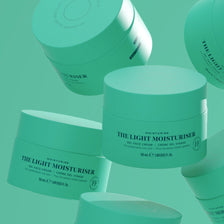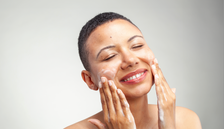Skin Rocks Retinoids
Hydroxypinacolone retinoate, or HPR, is a vitamin A derivative – a type of retinoid. It is also commonly referred to by its trade name, Granactive Retinoid, which has a slightly different meaning (more on this later). Before we deep-dive into this ingredient, let’s remind ourselves about retinoids and what they are.
What is a retinoid?
Vitamin A is retinoic acid. A retinoid is a vitamin A derivative. Some common examples of retinoids in skincare are retinol, retinal and retinyl palmitate. Retinoids have several skin benefits such as reducing the appearance of fine lines and wrinkles, reducing pigmentation and improving skin texture (for more on this, see our vitamin A Think Science ingredient glossary).
What is retinoic acid?
Retinoic acid is the active form of vitamin A. It is bioavailable to the skin (aka, it’s the form that your skin actually uses). So, when you apply any vitamin A derivative to your skin, it will need to convert to retinoic acid to have the same effect. You can read more about this in our ‘Vitamin A Stages of Conversion’ article, but the bottom line is that each conversion step needed will weaken the product - the fewer the conversion steps, the better. For context, retinol esters (such as retinyl palmitate) require a minimum of three conversions to reach the active form. Retinol requires two and retinaldehyde (retinal) requires just one step.
So, what is HPR?
HPR is an ester form of retinoic acid. It is unlike retinol esters, which require a minimum of three conversion steps to reach the active form; due to its close relation to retinoic acid (it is a retinoic acid ester), HPR does not need to go through the same steps of conversion as other retinoids do – it is already bioavailable to the skin as it is.
How does HPR compare to other retinoids?
If we had to rank HPR with other retinoids, in terms of efficacy, HPR sits at around the same level as retinal (i.e., more effective than retinol, less than retinoic acid), yet in terms of irritation, it sits around the same level as retinol esters (i.e., least irritating). Because of its ester structure, HPR is oil-based and is, therefore, gentler on the skin than retinoic acid. HPR has a low potential for irritation and is suitable for sensitive skin. Research has shown that HPR induced significantly less skin irritation than the same concentration as retinol, whilst still providing the same benefits to the skin. So, you can see why HPR is becoming more popular.
How is HPR different to Granactive Retinoid?
Granactive Retinoid is the trade name for HPR (think Nurofen vs ibuprofen). Trade names in cosmetics are used to describe blends of ingredients from specific suppliers. This is where we should talk a little about blend vs active ingredients.
Blend vs active ingredients
The simplest way to put it is that your active ingredient is mixed with another ingredient/other ingredients to make a blend. Think of dissolving a Berocca in a glass of water – imagine the Berocca is your active ingredient and your water is your solvent. Once fully dissolved, this is the form we consume – this is your blend.
So, Granactive Retinoid is the trade name for a blend of HPR (your active ingredient) plus solvent (in this case, just one solvent called dimethyl isosorbide). The solvent in this instance is added to enhance the delivery of HPR into the skin. Granactive Retinoid contains 10% HPR – the other 90% is your solvent. So, if your product is ‘2% Granactive Retinoid’, what this means is that it contains 0.2% of the active ingredient, HPR. Do be wary of this, as this labelling terminology can be confusing for consumers.
HPR-containing products we recommend:
- Zelens Power A
- The Ordinary Granactive Retinoid 2% Emulsion
- Skin Rocks Retinoid 1
- Skin Rocks Retinoid 2
- Sunday Riley A+ High-Dose Retinoid Serum
Words by Ceyda Faik-Yildirim MSci (Chemistry) – Team Skin Rocks




























